Razvan-Gabriel Dumitru
ConciseRL: Conciseness-Guided Reinforcement Learning for Efficient Reasoning Models
May 22, 2025Abstract:Large language models excel at complex tasks by breaking down problems into structured reasoning steps. However, reasoning traces often extend beyond reaching a correct answer, causing wasted computation, reduced readability, and hallucinations. To address this, we introduce a novel hyperparameter-free conciseness score used as a reward signal within a reinforcement learning framework to guide models toward generating correct and concise reasoning traces. This score is evaluated by a large language model acting as a judge, enabling dynamic, context-aware feedback beyond simple token length. Our method achieves state-of-the-art efficiency-accuracy trade-offs on the MATH dataset, reducing token usage by up to 31x on simple problems while improving accuracy by 7%, and on the hardest problems, it outperforms full reasoning by +7.5% accuracy with up to 3.6x fewer tokens. On TheoremQA, our method improves accuracy by +2.2% using 12.5x fewer tokens. We also conduct ablation studies on the judge model, reward composition, and problem difficulty, showing that our method dynamically adapts reasoning length based on problem difficulty and benefits significantly from stronger judges. The code, model weights, and datasets are open-sourced at https://github.com/RazvanDu/ConciseRL.
CopySpec: Accelerating LLMs with Speculative Copy-and-Paste Without Compromising Quality
Feb 13, 2025Abstract:We introduce CopySpec, an innovative technique designed to tackle the inefficiencies LLMs face when generating responses that closely resemble previous outputs. CopySpec identifies repeated sequences in the model's chat history and speculates that the same tokens will follow, enabling seamless copying without compromising output quality or requiring additional GPU memory. To evaluate the effectiveness of our approach, we conducted experiments using five LLMs and five datasets: MT-Bench, CNN/DM, GSM-8K, HumanEval, and our newly created dataset, MT-Redundant. MT-Redundant, introduced in this paper, transforms the second turn of MT-Bench into a request for variations of the first turn's answer, simulating real-world scenarios where users request modifications to prior responses. Our results demonstrate significant speed-ups: up to 2.35x on CNN/DM, 3.08x on the second turn of select MT-Redundant categories, and 2.66x on the third turn of GSM-8K's self-correction tasks. Moreover, we show that CopySpec integrates seamlessly with speculative decoding, yielding an average 49% additional speed-up over speculative decoding for the second turn of MT-Redundant across all eight categories. While LLMs, even with speculative decoding, suffer from slower inference as context sizes grow, CopySpec leverages the expanded context to accelerate inference, making it faster as the context size increases. Our code and dataset are publicly available at https://github.com/RazvanDu/CopySpec.
Change Is the Only Constant: Dynamic LLM Slicing based on Layer Redundancy
Nov 05, 2024
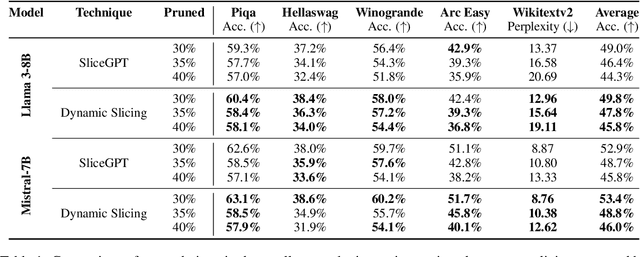

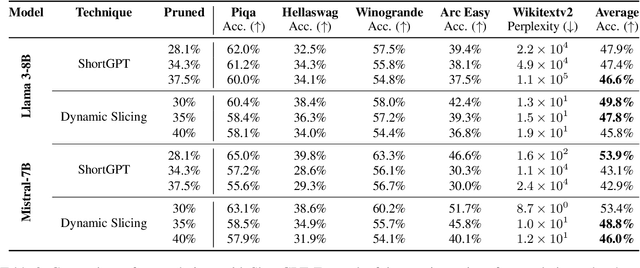
Abstract:This paper introduces a novel model compression approach through dynamic layer-specific pruning in Large Language Models (LLMs), enhancing the traditional methodology established by SliceGPT. By transitioning from constant to dynamic slicing, our method leverages the newly proposed Layer Redundancy (LR) score, which assesses how much change each layer changes its input by measuring the cosine similarity of the input to the output of the layer. We use this score to prune parts of individual layers based on redundancy in such a way that the average pruned percentage for all layers is a fixed value. We conducted extensive experiments using models like Llama3-8B and Mistral-7B on multiple datasets, evaluating different slicing bases and percentages to determine optimal configurations that balance efficiency and performance. Our findings show that our dynamic slicing approach not only maintains but, in many cases, enhances model performance compared to the baseline established by constant slicing methods. For instance, in several settings, we see performance improvements of up to 5% over the SliceGPT baseline. Additionally, a perplexity decrease by as much as 7% was observed across multiple benchmarks, validating the effectiveness of our method. The code, model weights, and datasets are open-sourced at https://github.com/RazvanDu/DynamicSlicing.
Layer-Wise Quantization: A Pragmatic and Effective Method for Quantizing LLMs Beyond Integer Bit-Levels
Jun 26, 2024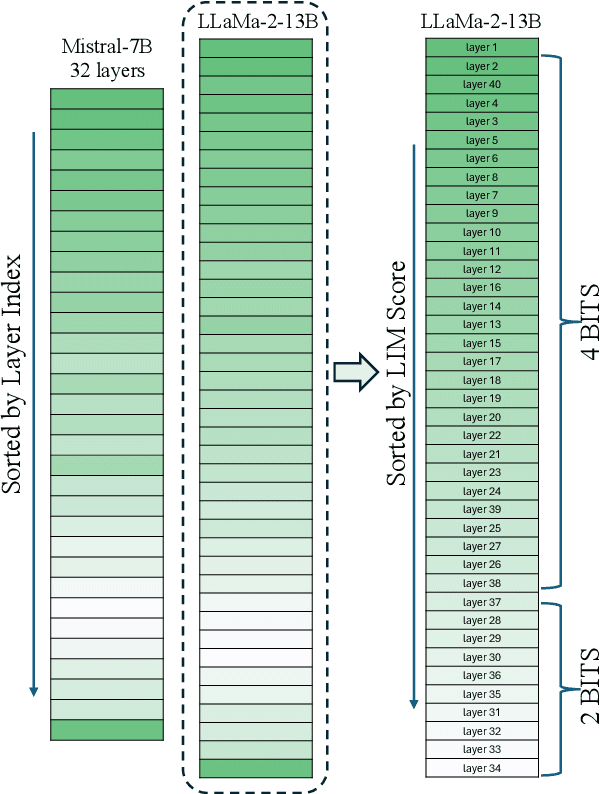



Abstract:We present a simple variable quantization approach that quantizes different layers of a large language model (LLM) at different bit levels. Specifically, we quantize the most important layers to higher bit precision and less important layers to lower bits to achieve floating point quantization levels. We propose two effective strategies to measure the importance of layers within LLMs: the first measures the importance of a layer based on how different its output embeddings are from the input embeddings (the higher the better); the second estimates the importance of a layer using the number of layer weights that are much larger than average (the smaller the better). We show that quantizing different layers at varying bits according to our importance scores results in minimal performance drop with a far more compressed model size. Finally, we present several practical key takeaways from our variable layer-wise quantization experiments: (a) LLM performance under variable quantization remains close to the original model until 25-50% of layers are moved in lower quantization using our proposed ordering but only until 5-10% if moved using no specific ordering; (b) Quantizing LLMs to lower bits performs substantially better than pruning unless extreme quantization (2-bit) is used; and (c) Layer-wise quantization to lower bits works better in the case of larger LLMs with more layers compared to smaller LLMs with fewer layers. The code used to run the experiments is available at: https://github.com/RazvanDu/LayerwiseQuant.
ELLEN: Extremely Lightly Supervised Learning For Efficient Named Entity Recognition
Mar 26, 2024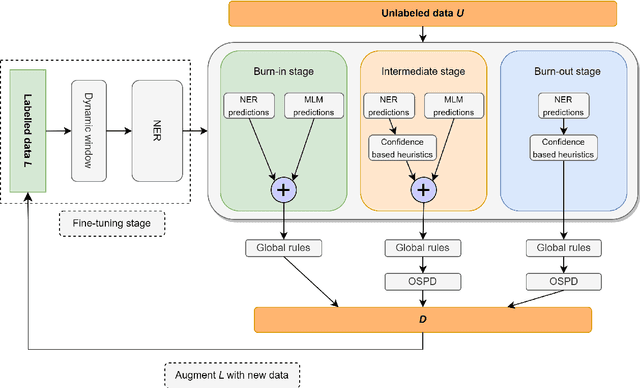
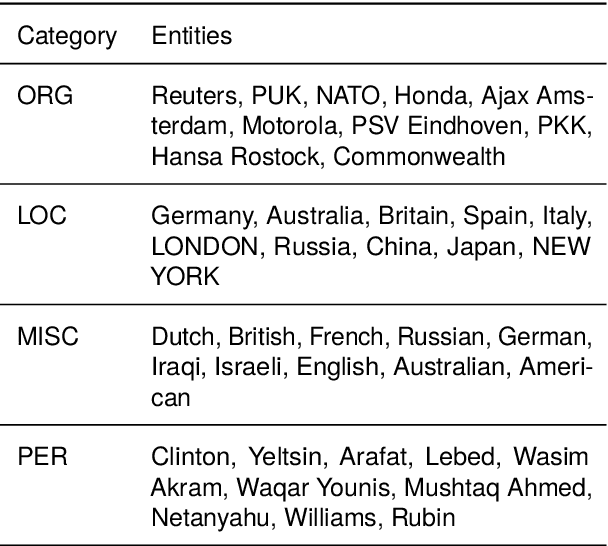
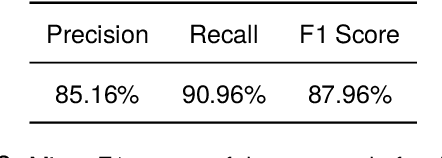
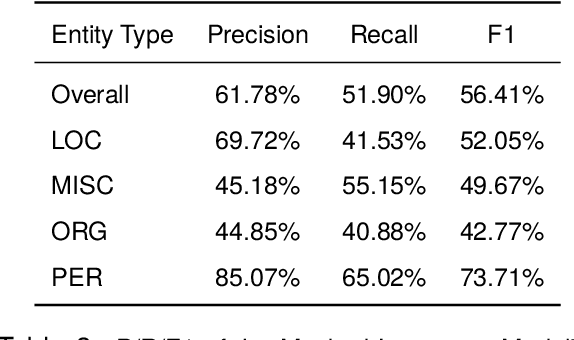
Abstract:In this work, we revisit the problem of semi-supervised named entity recognition (NER) focusing on extremely light supervision, consisting of a lexicon containing only 10 examples per class. We introduce ELLEN, a simple, fully modular, neuro-symbolic method that blends fine-tuned language models with linguistic rules. These rules include insights such as ''One Sense Per Discourse'', using a Masked Language Model as an unsupervised NER, leveraging part-of-speech tags to identify and eliminate unlabeled entities as false negatives, and other intuitions about classifier confidence scores in local and global context. ELLEN achieves very strong performance on the CoNLL-2003 dataset when using the minimal supervision from the lexicon above. It also outperforms most existing (and considerably more complex) semi-supervised NER methods under the same supervision settings commonly used in the literature (i.e., 5% of the training data). Further, we evaluate our CoNLL-2003 model in a zero-shot scenario on WNUT-17 where we find that it outperforms GPT-3.5 and achieves comparable performance to GPT-4. In a zero-shot setting, ELLEN also achieves over 75% of the performance of a strong, fully supervised model trained on gold data. Our code is available at: https://github.com/hriaz17/ELLEN.
Enhancing Transformer RNNs with Multiple Temporal Perspectives
Feb 04, 2024Abstract:We introduce the concept of multiple temporal perspectives, a novel approach applicable to Recurrent Neural Network (RNN) architectures for enhancing their understanding of sequential data. This method involves maintaining diverse temporal views of previously encountered text, significantly enriching the language models' capacity to interpret context. To show the efficacy of this approach, we incorporate it into the Receptance Weighted Key Value (RWKV) architecture, addressing its inherent challenge of retaining all historical information within a single hidden state. Notably, this improvement is achieved with a minimal increase in the number of parameters --even as little as $0.04\%$ of the original number of parameters. Further, the additional parameters necessary for the multiple temporal perspectives are fine-tuned with minimal computational overhead, avoiding the need for a full pre-training. The resulting model maintains linear computational complexity during prompt inference, ensuring consistent efficiency across various sequence lengths. The empirical results and ablation studies included in our research validate the effectiveness of our approach, showcasing improved performance across multiple benchmarks. The code, model weights and datasets are open-sourced at: https://github.com/RazvanDu/TemporalRNNs.
Using DUCK-Net for Polyp Image Segmentation
Nov 03, 2023Abstract:This paper presents a novel supervised convolutional neural network architecture, "DUCK-Net", capable of effectively learning and generalizing from small amounts of medical images to perform accurate segmentation tasks. Our model utilizes an encoder-decoder structure with a residual downsampling mechanism and a custom convolutional block to capture and process image information at multiple resolutions in the encoder segment. We employ data augmentation techniques to enrich the training set, thus increasing our model's performance. While our architecture is versatile and applicable to various segmentation tasks, in this study, we demonstrate its capabilities specifically for polyp segmentation in colonoscopy images. We evaluate the performance of our method on several popular benchmark datasets for polyp segmentation, Kvasir-SEG, CVC-ClinicDB, CVC-ColonDB, and ETIS-LARIBPOLYPDB showing that it achieves state-of-the-art results in terms of mean Dice coefficient, Jaccard index, Precision, Recall, and Accuracy. Our approach demonstrates strong generalization capabilities, achieving excellent performance even with limited training data. The code is publicly available on GitHub: https://github.com/RazvanDu/DUCK-Net
 Add to Chrome
Add to Chrome Add to Firefox
Add to Firefox Add to Edge
Add to Edge